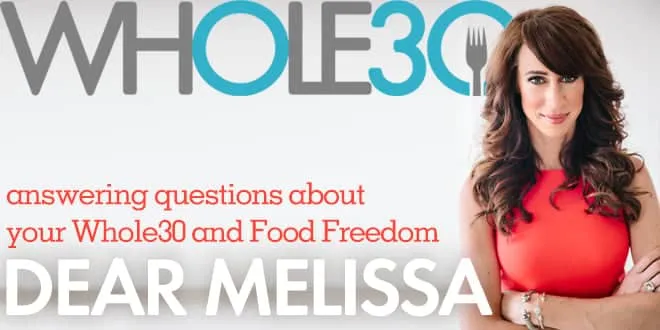Dear Melissa,
I am getting ready to start my first Whole30. I understand that you’re not supposed to replace sugar cravings with fruit or other compatible but sugary foods but what about savory cravings? For example, I often crave Buffalo wings. Is it going against the rules and spirit of the program to make compatible Buffalo wings or use compatible hot sauce to flavor food during the Whole30? – Jessica B., Orlando FL
Dear Jessica,
This is a great question! What you’re referring to is discussed in detail in the Sweets, Treats, and Food Fixations section of The Whole30, where we talk about NOT recreating sweets or treats on the program, and NOT continuing to feed your Sugar Dragon with technically-compatible foods.
The principle behind this theory is simple: If you’re trying to break bad habits and unhealthy emotional relationships with food, let’s not replace an off-limits “triggering” food with a compatible “triggering” food. This is easily demonstrated with sugar; the one food people say makes them feel most out of control. After a hard day at work, a fight with your partner, a stressful event, or a bout of loneliness, it’s common to find yourself repeatedly reaching for sugary foods like chocolate or cookies. If that’s your context, we want you to break that emotional attachment, and find other ways to relieve anxiety, self-soothe, or show yourself love.
In this situation, reaching for a Larabar instead of a candy bar ISN’T breaking the cycle … you were triggered, and once again, you reached for the sweetest thing you could legally eat on the Whole30! That’s why we discourage feeding your Sugar Dragon with “compatible” treats like dried-fruit-and-nut bars or dates with almond butter while on the program—because your brain doesn’t know the different between a candy bar and an RXBAR, it just knows “I felt bad, so I ate sugar to feel better.” And since that cycle is so psychologically damaging (often prompting stress, guilt, and shame) we really want you to actively change it during your program.
However, there are other swaps that are just fine—healthy, even—on your Whole30. Let’s take Buffalo wings. That’s a savory, whole, nutrient-dense food featuring complete protein from the chicken and healthy fat from the sauce; hard to over-eat because of the nutrition and satiety factors. Whole30 Approved Buffalo sauces from The New Primal or Tessemae’s can be a flavor-enhancing addition to your Whole30… but to truly embrace the spirit and intention of the program, you have to consider whether it’s right for YOU.
Before swapping out ANY food that might be psychologically or emotionally problematic for you with a Whole30 Approved version, ask yourself these questions:
1. Is this a food I tend to overconsume, or consume mindlessly?
2. Is this a food I tend to reach for when I’m stressed, anxious, bored, or lonely?
3. Is this a food that tends to bring on guilt, shame, or stress after I eat it?
4. Is this food part of a habit or cycle I’d really like to change during my Whole30?
If you answer “yes” to any of these questions, PAUSE. Just because your “trigger” food isn’t typical doesn’t mean this isn’t worth addressing in your Whole30. If you’ve been reaching for Buffalo wings after every break-up, fight with your Mom, or tough day at work, I’d recommend you find another way to satisfy those emotions during your Whole30, and skip the Buffalo replacement for now. But if you just really LIKE the flavor of Buffalo sauce and have no emotional attachment or bad habits associated with this food, then substitute away!
This is the only “grey area” in the Whole30 rules. Not everyone’s “trigger” foods are the same, and just because we don’t specifically rule it out during your program (as we do with pancakes or brownies) doesn’t mean it belongs in YOUR Whole30. However, most people don’t come home from a stressful day at work and throw themselves face-first into a vat of mayo… which is why making your own mayo, subbing traditional rice for cauliflower rice, or recreating pasta with zucchini noodles are common Whole30 hacks. Unless you have a specific habitual or emotional attachment to them, subbing these foods out with compatible versions is a healthy practice in your Whole30, and adds flavor, variety, and nutrition to your meals.
The key is committing to self-awareness and brutal honesty when you’re answering those four questions above, and always follow the Whole30 golden rule for maximizing success… when in doubt, leave it out. Remember, it’s only 30 days.
Best in health,
Melissa
For more guidance on sweets, treats, emotional eating, and habits during your Whole30, see page 95 in The Whole30: The 30-Day Guide to Total Health and Food Freedom.
















